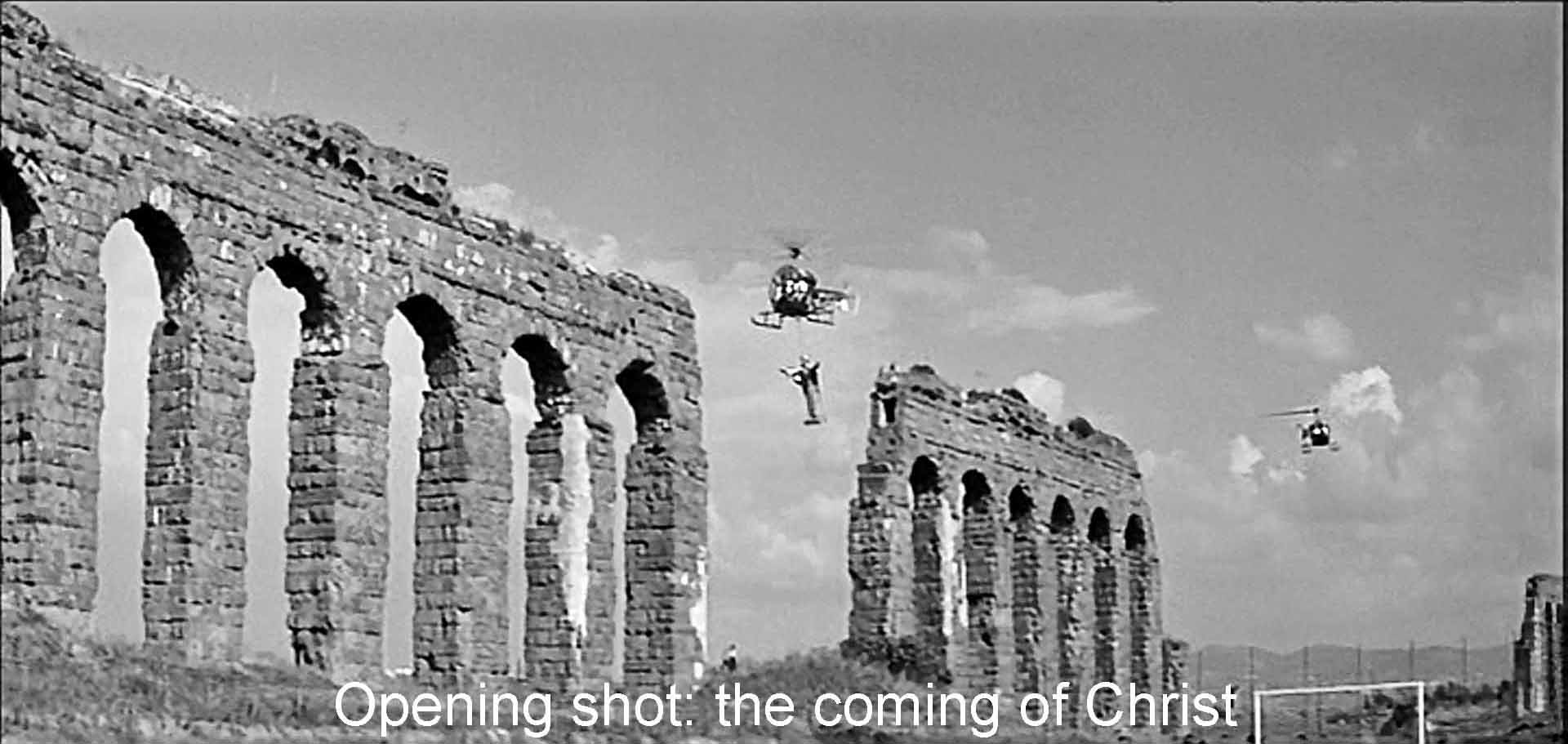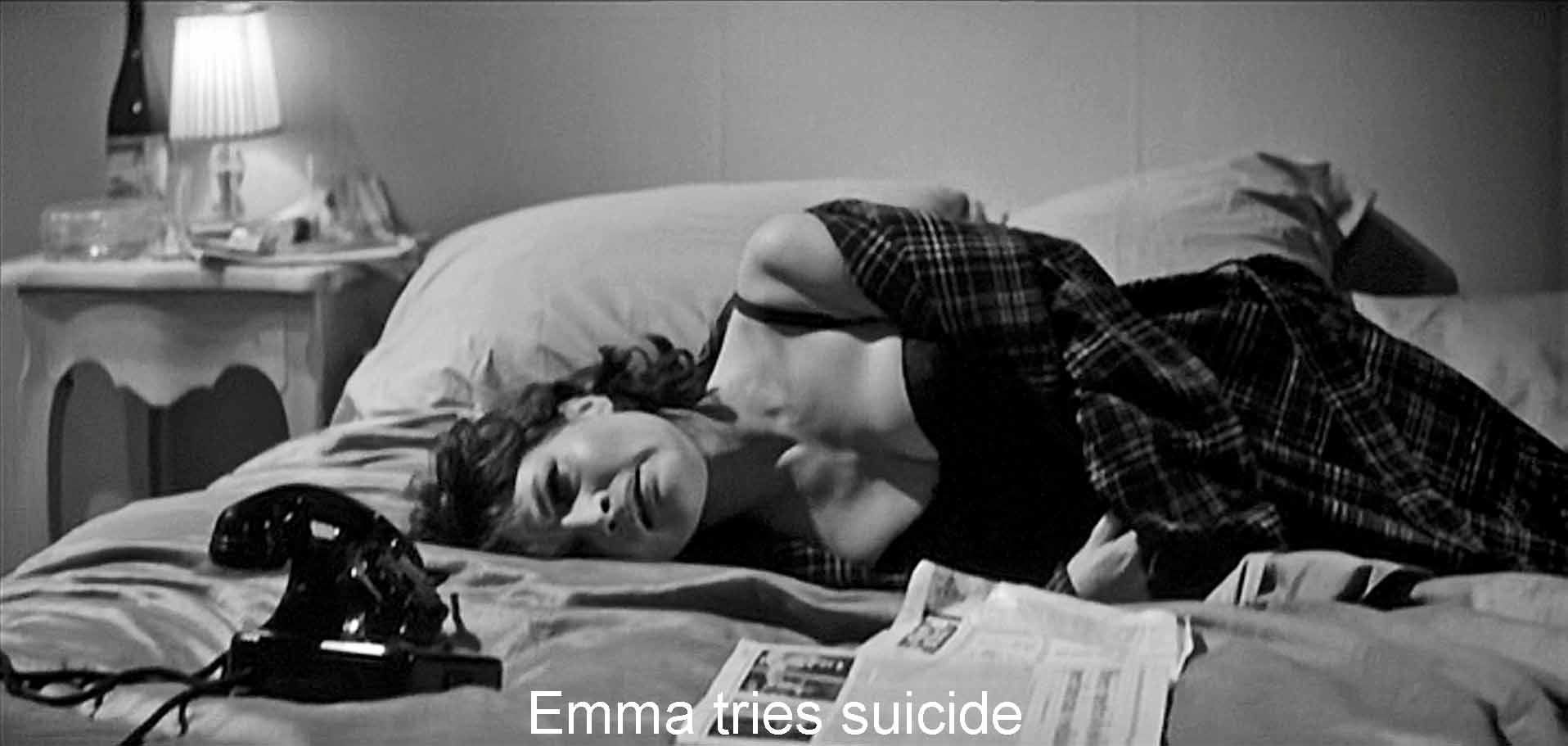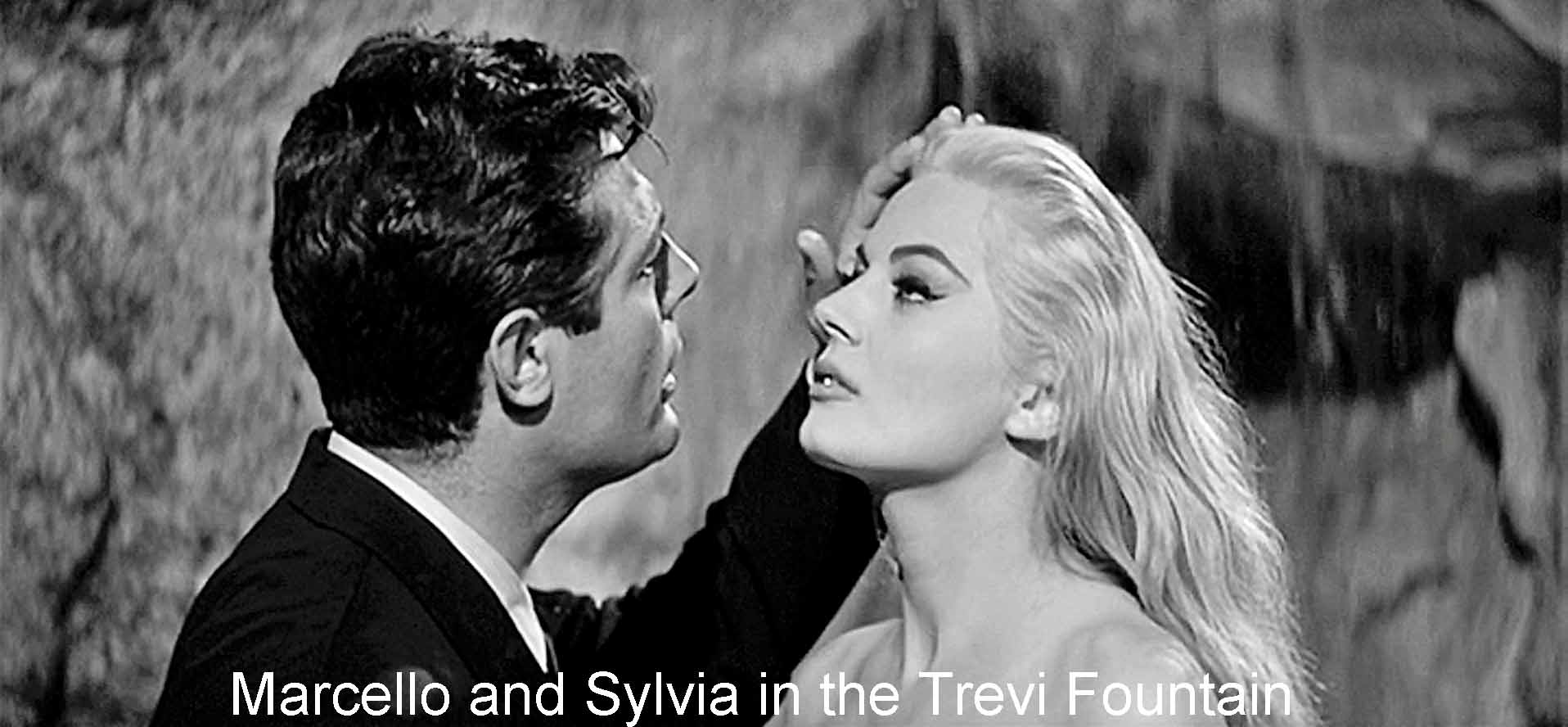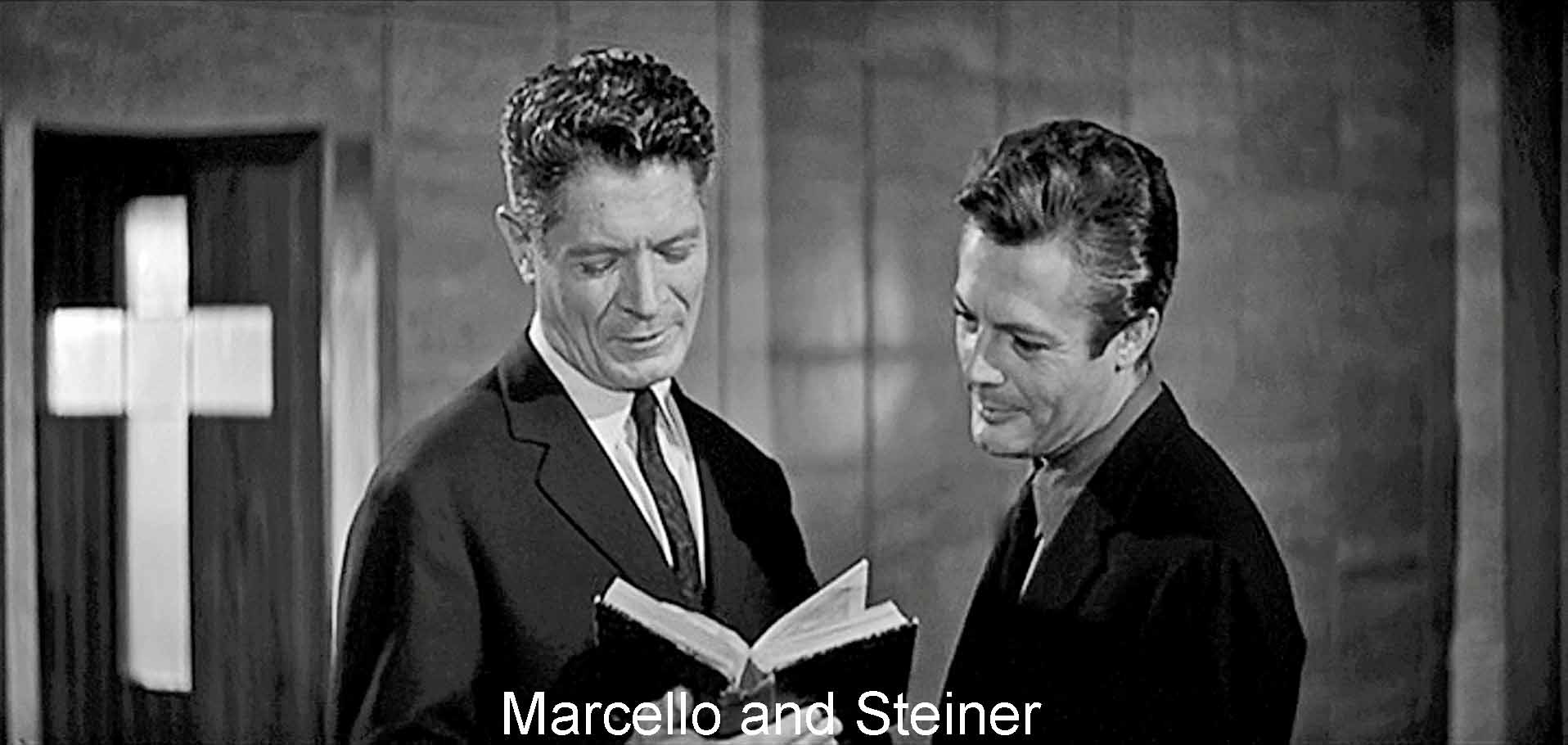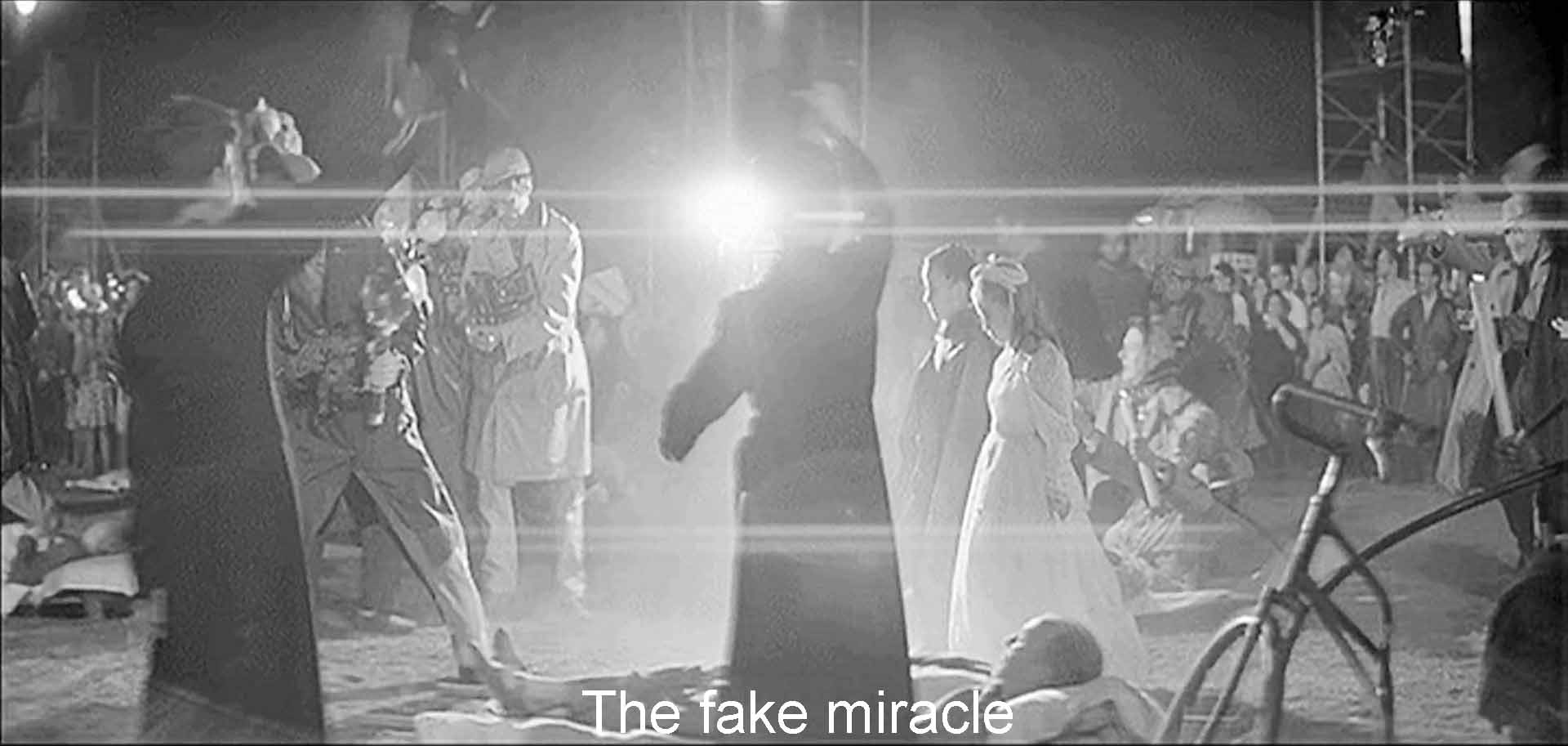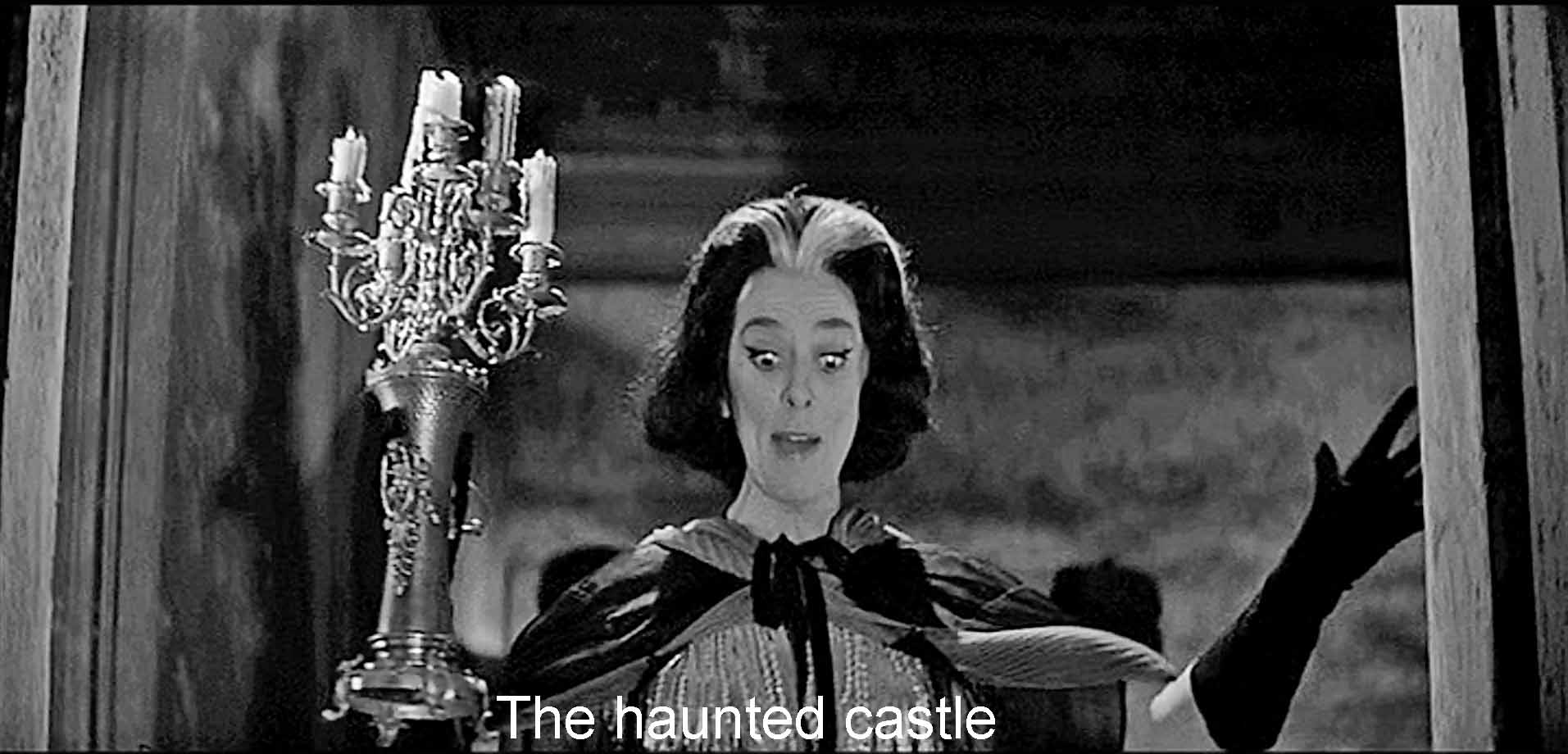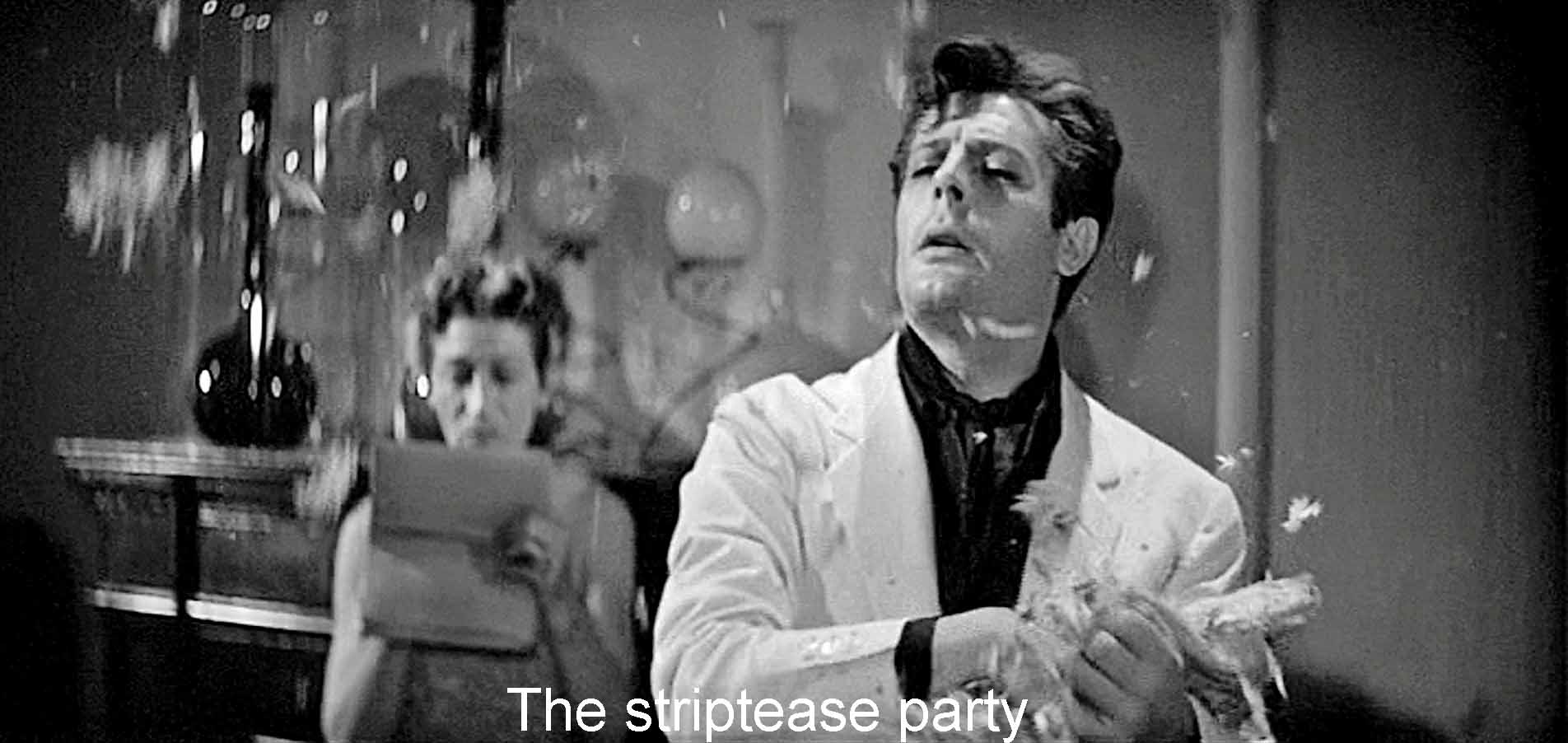Enjoying: Just let the film flood your mind, but keep in the back of your mind the basic idea: sight and images vs. sound and words.
Three-hour, three-million gross, triple-goddessed, church-banned, myth-packed, and Totalscoped, La Dolce Vita amazes indeed the very faculty of eyes and ears. Eyes and ears are not just the targets, though, but recurring symbols for what author-director Fellini has on his mind. His protagonist, Marcello (Marcello Mastroanni), is a reporter and would-be novelist, a man questing (admittedly, rather ineffectively) after truth in the form of sounds and language. Indeed, at one point, Marcello rather shamefacedly mumbles something of the sort. As against this basic stance for sound and language, Fellini shows his people preoccupied with seeing, most obviously in the form of the ubiquitous papparazzi, the photographers who contrast with the verbal reporter Marcello—they swarm about virtually everyone and everything as though Sartre’s flies had been outfitted with flash cameras.
Images of seeing and being seen run all through the film, as, for example, the sunglasses everybody wears. (If It Happened One Night ruined the men’s undershirt industry, surely La Dolce Vita will turn prescription sunglasses into a major consumer item.) Sights in La Dolce Vita are mostly Ziegfeldian sights of women, culminating in Nadia Gray’s striptease in the final party, but represented earlier, for example, by the pictures of female ancestors in the “haunted castle” sequence, the sight of the magnificently pneumatic Sylvia (Anita Ekberg) or the non-miraculous non-sight of the Virgin Mary in the televised “fake miracle.”
Against these images of seeing and being seen, Fellini poses fewer, but far more striking images of hearing. At the home of Steiner, Marcello’s intellectual friend (Alain Cluny), we hear folk songs and poetry and a tape recording of the sounds of nature; conversation reigns supreme. Steiner himself had earlier gone into a church to practice the Toccata and Fugue in D Minor—after the rock ’n roll and other raucous cacophonies, you can almost feel the Bach soothe your ear. At one point, Marcello retires to the seashore to renew his work on the Great Italian Novel; he cannot write for the loudness of the song from a jukebox played by a virginal young blonde waitress he calls an “Umbrian angel” The song is “Patricia,” which Fellini presses into service later as the music for the striptease; like the Bach, it, too, is played on an organ.
Nino Rota makes the music of the film parody itself, and the point of Fellini’s images of sound seems to be that they fail. It was, of all people, Robinson Crusoe (though he was surely not the first) who pointed out that sound and language are the means by which human beings can achieve more than an animal relation with each other. Sound and language in La Dolce Vita, however, seem always to fail to create such a relationship. In the “haunted castle” sequence, Maddalena (Anouk Aimée), one of Marcello’s light o’ loves, seats him in a room and goes outside to talk to him through a speaking-tube arrangement (a kind of “ear of Dionysius”). In the only serious moment of their relationship, we hear her propose marriage to him; we see her giving herself to another man.
The opening and closing bits (they are scarcely episodes) frame this recurring contrast of sight and sound. The opening (already, in the two fast years since the film was released, a classic among openings) shows a gilt image of Christ helicopter-borne over the Eternal City, which Fellini renders as a vast flux of running children and rising buildings; a second helicopter follows, carrying reporter Marcello and his photographer sidekick, Papparazzo (Walter Santesso—it is a measure of the film’s influence that the character’s name has become the general term for this kind of photographer). They are apparently fishing for a story. Beneath them, they see a far more gripping sight than the Second, airborne Coming: four girls in bikinis sunbathing on a roof. As the helicopter hovers overhead, Marcello tries to speak to them, but they cannot hear one another over the noise of the chopper. “In the beginning was the Word” and “The Word was made flesh”—bikinied girls. The pattern is: the sight of a symbol; the sight of woman; the failure of sound.
In the final shots, Marcello and assorted sodomites, usurers, grifters, and fornicators from the striptease party drift down to the sea (in shots reminiscent of Botticelli). At the sea’s edge, some fishermen pull up a huge monstrous sea-creature. I cannot help thinking of the ending of Yeats’ “The Second Coming”: “And what rough beast, its hour come round at last, / Slouches toward Bethlehem to be born.” The fish is an ancient symbol for Christ, and surely this creature parodies the coming of Christ in the opening of the film. I'll follow the critics who call it a “devilfish,” though that's not really accurate. In a final triumph for visual culture, he camera closes in on its still-staring eye. As Marcello turns to go, the “Umbrian angel” appears on the shore nearby, but there is water between them, and though he sees her and she him, they cannot hear each other for the sound of the waves. He shrugs indifferently and leaves; she turns to watch him go. In a brilliant cinematic touch, Fellini pans the camera as she turns so that the final shot is an extreme close-up of the Umbrian angel staring out at the audience—or us staring at her: the audience has become image, and the image is the audience.
The rough beast from the sea, with its overtones of the birth of some mute and nameless horror from the depths of the unconscious, has provoked a good deal of speculation. Surely the most ingenious suggestion is Sight and Sound’s, that it represents Wilma Montesi. Time, following some Christian bent, argues for the beast of the Apocalypse rising up out of the sea, the devilfish as antichrist; the opening bit is the Second Coming, and the film as a whole becomes an allegory of the seven nights of destruction in Revelation. Others have suggested an allegory on the Inferno with Marcello as Dante, his downward spiral through the sins of contemporary Rome culminating in the ninth circle with the devilfish as Lucifer, complete with three jellyfish dangling from his mouth. La Vita Nuova or the canzonieri might be relevant to a film which so stresses the image of woman.
All are possible—what is not possible is to see La Dolce Vita as “in the main a study of sexual manners,” as simply “a sensational presentation of certain aspects of life in contemporary Rome.” Some critics want to impose on one Italian, Fellini, the neo-realismo of other Italians. Behind this kind of mis-seeing lies a nationalistic view of the film as simply the expression of a particular time and place; also a notion of the film like that of Siegfried Kracauer, the film as nonart, as “the redemption of the real,” a view which values in a film only its formal realism. Fellini let himself in for this kind of mis-seeing by basing the public episodes of La Dolce Vita on items reported in the Italian press. He is, of course, formally realistic, but that is not the important fact. Fellini is exploring human nature, fallen human nature.
La Dolce Vita seems more tied to reality than Fellini’s earlier work, but only “seems.” It really has that same strange hankering after myth as his other films. His script for The Miracle reached essentially toward the traditional mating in the fields of sun-god and m/ortal woman. The White Sheik with its horseplay on different kinds of hats balanced the impotent male of church and marriage against the absurdly sexual male of the fumetti (visual images again). I Vitelloni constitutes a parody of the whole male pantheon, while, in Le notti di Cabiria, a tawdry and pathetic image of Venus renews herself in water after venal Adonises have chosen and abused her. La Strada is the clearest of them all, a classic agon between eiron and alazon over a (more or less) mute woman that could have come straight out of Cornford’s Origins of Attic Comedy. La Dolce Vita has the same theme and mythic dimension as the others, men overpowered physically, morally, or psychologically by the gorgon-like image of woman. As Steiner says, “I am only this tall,” and he holds up his finger. In the “fake miracle” (an earlier form of which appeared in Cabiria), an old woman gives us the tip-off. As the television cameras and photographers close in on the two children who have been gulled into saying they saw the Virgin, the crone says, “What does it matter whether it was the Virgin or not? Italy is full of strange cults.” And indeed Fellini’s Italy is.
The first one we see, the first full episode in the film, is a kind of temple prostitution. The gilt Christ of the opening shots jump-cuts into the shrill sinuosities of a gilt Siamese dancer in a night club where Marcello picks up a rich nymphomaniac, Maddalena (and the name, I take it, is not without significance). They ride off in her white Caddy convertible, boredly pick up a prostitute, and drive her home. Fellini goes out of his way to make them go out of theirs, go underground to the prostitute’s basement apartment, cross the waters of her flooded basement, and there, in this doubtful chthonic sanctum, make love.
The second is the advent through the air from another land of an Aphrodite Pandemos, Anita Ekberg, cast as a Hollywood love-goddess, Sylvia (again, the name is not without significance). Ritually, she is offered the fruits of the Roman fields (in the form of a giant pizza); then, in an hilarious press conference, she is consulted as an oracle. During the day, she bounds up the endless stairs to the top of St. Peter’s, dressed in a parody of a priest’s gown. The true aphroditic rituals, however, took place on the tops of mountains or in caves, and that night, bobbling out of her evening grown, Sylvia leads a revel through the Baths of Caracalla, complete with rock ’n roll Orpheus and a faun in the form of a goatish American actor on whose shoulders she rides. “Why, Federico,” Miss Ekberg is said to have remarked during the filming of these sequences, “you are making a fool of me.”
Despite this insight, Ms. Ekberg can take comfort in the fact that Fellini was also making her a goddess. In some rituals, her celestial prototype did indeed ride a goat, and Marcello tells her she is mother, mistress, wife, home, “everything.” They ride off in his Triumph, where he makes the old college try, but cannot find a place to go. (Throughout the film, blondes are unattainable-or at least unattainable by Marcello—unlike the brunettes, for example, Maddalena.) Our pandemotic love-goddess, however, seems (again, like Aphrodite) concerned as much with mothering animals as with mothering Marcello; anyway, she howls like a dog on a mountaintop, and in an exquisite sequence picks up a stray white kitten and, holding it before her like a monstrance, glides through the narrow corridors of midnight streets. She strides into the Trevi fountain; Marcello follows: “You’re right—I’m on the wrong track—we all are.” She puts water on his hair in a mock baptism, and to cap the parody, just then the fountain is turned off. They return to her hotel, where her opposite number, Lex Barker as a dipsoid American actor, awaits them, another mythic figure: “To think he once played Tarzan,” sighs a papparazzo.
There are other “goddesses”—the missing Virgin Mary in the fake miracle; at Steiner’s house, an old artist cries the praises of Oriental women, notably Mother Eve. In the haunted castle sequence, Maddalena standing before a row of matrilinear portraits puts a veil over her face; Marcello seduces a mysterious otherworldly “Lady Jane” with streaks in her hair like antennae: the ghosts, nighttime, the cemetery, the surrounding plutocracy give the whole episode a persephonic aura. Finally, of course there is the “Umbrian angel,” the virgin by the sea, image of a renewal and innocence, a kind of Aphrodite Urania, whom Marcello cannot accept.
In this matriarchal world, men become mere consorts, sacrificial lover-kings, ridiculous, impotent. The clearest case is Marcello’s father (Annibale Ninchi) who turns up just before the necrotic haunted-castle sequence. An aging lecher, he gets his son to take him to an old-fashioned night-club, where the walls glitter like a temple’s and everywhere there are statues of women. During the conversation, we find he was usually away from home, a wine merchant and rather a philanderer, indeed, “sold wine all up and down Italy.” Playing parlor-tricks with one of the chorines, he is compared to a donkey. Meanwhile, the acts of the nightclub entertainers parody still other aspects of ass-headed Dionysus. The first routine shows a triad of mock-ferocious cat-women ridiculing their quite ineffectual male tamer; the second shows us girls in a Charleston routine out of the father’s youth; finally, in an exquisite act, the clown Polidor appears as a doddering Pied Piper, awed by the images of woman about him. A few pathetic notes of his almost limp trumpet and he shuffles out, trailing clouds of—empty balloons. Marcello’s father goes to the chorus girl’s apartment (“to eat spaghetti”), but suffers some unnamed weakness as they are making love. Pathetic, aging, his face always turned away, he wants only to return to Marcello’s mother. In one of the most beautiful moments in the film, sick and exhausted as he is, he stoops and silently smooths out the bed, removing his last trace; it is as though he had never been. So much for fatherhood.
Throughout the film, from the vulgarized Christ at the opening to the transvestite dance of the homosexuals at the end, man seems weak and helpless. Throughout, women lead men—Maddalena leads Marcello to the prostitute’s apartment; Sylvia bounds up the steps of St. Peter’s leaving behind clusters of exhausted Romans, and the haunted castle sequence ends with the old principessa-matriarch leading the shamefaced “men” of the tribe off to Mass. Throughout, men seem awed, overcome by women, often trying to make themselves into women, sinking down into women. The men seem unable to get places; they have to clamber, grope, fly, break into places women seem to sink into effortlessly. When men do achieve heights, “rise above it all,” they flag and gasp, revealing their impotency—Marcello climbing St. Peter’s; Marcello’s father up in the chorine’s apartment; the cameramen’s lights on high platforms shattering and popping in the fake miracle; the insignificance of the helicoptered Christ; the insignificance of our modern Mars—Marcello Rubini.
The exception (for a time, anyway) to all this is Steiner, Marcello’s intellectual friend whose short unhappy life forms the most puzzling episode of the film. Unlike the other characters whose lives are dominated by sights and shows, Steiner lives in a world of sound and language. When we first see him, he is returning a Sanskrit text. He offers Marcello jobs in publishing and encourages him in his writing. Steiner, moreover, is a father with a lovely wife and charming children. Home-spun, craggy (Fellini originally wanted Henry Fonda for the part), he alone seems master of his fate. Then, inexplicably, Steiner commits suicide, destroying not only himself, but his children, destroying, in effect, his own fatherhood, his limited claim to be part of the flow of life, a total suicide. The film gives no particular reason for Steiner’s suicide. It seems just one more in the long series of improvisations that make up La Dolce Vita. Impulse and improvisation are the ways the other characters work, however—not Steiner. In the first scene in which he appears, he starts to improvise jazz on the church organ, but at a gentle rebuke from the priest obediently shifts to the Toccata and Fugue, a frozen, “perfected” improvisation, as it were. At his house, he says, “In a work of art, everything is planned and perfect. We need to be a work of art, detached, perfect, in suspended animation,” and yet, he also said his own life was too much so (the goody-goody quality of everything associated with Steiner). There seems to be no room in his life for the new, the unexpected. His suicide is the only improvisation left him and, at the same time, the closing or framing of his perfected life. It leaves his wife to be photographed by the papparazzi, she, now, image of the mater dolorosa. Quite the opposite is the only other sustained human relationship Marcello has in the course of the film, that with his mistress, Emma. Squabbles, flirtations, attempted suicides, reconciliations, their relation is one long series of improvisatons as she tries to “catch” him, fix him into matrimony and fatherhood, a Fury valiantly striving to be a hearth-goddess.
The film, then, uses its two central images, sight and sound, to set off men against women. The women are goddesses, mythical, unreal belles dames sans merci, the sight of whom bewitches men into a kingdom of improvisation and illusion. Man is impotent, helpless, Marcello’s dying father or Steiner, with his sounds and language, frozen, turned into stone by the fixity of his life. (Indeed, sacred to Cybele was a small, needle-shaped meteoric stone acus, supposed to have fallen from the heavens.) Marcello, Everyman, is caught between these two alternatives, male and female, his mistress vainly seeking to play the role of goddess and petrify him into matrimony.
These themes all come together in the final dreary episode, the despairingly hedonistic party that follows Marcello’s appearance at the scene of Steiner’s suicide. The subjugation of men culminates in the dance of the homosexuals and gigolos, and the image of woman culminates in the striptease (to the same song the Umbrian angel had played on the jukebox). Marcello presides over the dispirited merrymaking (the only case where a man is the “leader”), and as the party whimpers to its close he baptizes the departing revelers with feathers, as though he himself were plucking the storm-bringing chickens of Mother Carey (mater cara), a grim parody of the earlier, Ekbergian baptism, just as his white suit is now the negative of the tuxedo he wore in the earlier episode. The effect is rather like snow, perhaps the snow of the ninth circle, perhaps also that “snow falling faintly through the universe and faintly falling, like the descent of their last end, upon all the living and the dead.” This, the last party, gives way to the film’s final image of man, a devilfish gasping in air, an eye caught in a net, and the final image of woman, the Umbrian-Uranian angel.
As with any important work, La Dolce Vita defines its own art. Fellini’s concern about turning people into images finds its expression in what might be called the rotogravure style of the film. Fellini had both sets and costumes of La Dolce Vita designed to photograph in exaggerated blacks and whites, so that everything in the film would have the hard, contrasty look of a flash photo. The film itself seems almost to be composed as a series of stills rather than as a moving picture. Fellini’s sense of the new, the unexpected, his theme of improvisation, finds its expression in the episodic structure (like a circus). Fellini’s brilliant editing also suggests a kind of impulse or improvisation (the best example being the opening where the gilt image of Christ suddenly, startlingly becomes a gilt Siamese dancer). This sense of improvisation, by the way, is not inappropriate for perhaps the only major director of his time who liked working on a chaotic set, who insisted a script could only be an outline and “wrote” his pictures by improvising on the set.
As in his earlier films, Fellini is essentially getting at a view of man as helpless and abject before the gorgon-like, all-powerful image of woman (in Vitelloni, for example, the gallant in the religious-goods shop surrounded by images of the Virgin, or—the most magnificent shot in that film—the half-wit worshipping a statue of an angel by the sea). Here, again, the theme fits a director who will look through thousands of photographs to get an actor with the right image; indeed, he claims to have interviewed 10,000 actors for La Dolce Vita, truly a cinematic Ziegfeld. The good, grey Times insists on a Fellini “taking the temperature of a sick world,” and that is no doubt true. But Fellini is also preoccupied with dehumanizing people, making them into things (Cabiria) or mythic consorts (La Dolce Vita) or false gods (The White Sheik), but in every case, dehumanizing them, making them into images—not an unnatural preoccupation for a man whose work in life is to turn people into celluloid.
This essay is adapted from Norman N. Holland, “The Follies Fellini,” Hudson Review, 14.3 (Autumn, 1961), 125-131.
Enjoying: This film will repay endless re-viewing. Go back or think back to any given episode and think about it in terms of sight and sound, and you will find all kinds of resonances.
